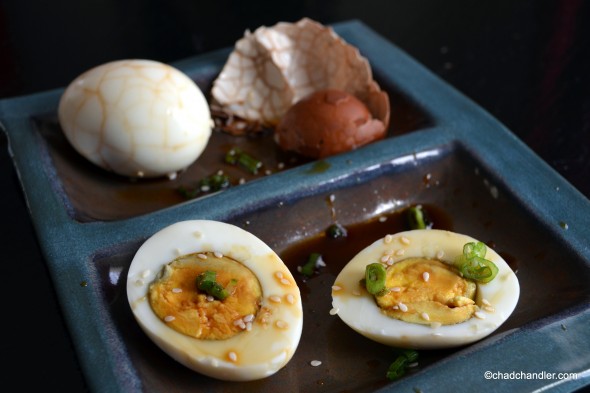
When the wife and I were at the Lu San Chinese Garden in Portland, we sat down for some tea and snacks. I ordered a marbled tea egg, which is an egg that’s been hard-boiled and steeped in a mixture of tea and soy sauce and other aromatics. I thought it was delicious and decided I’d try to make some myself.
Apparently, The marbled tea egg is the Chinese equivalent of the American hot dog. It’s sold in malls, at sporting events, and on street corners. I can’t decide if that would smell better or worse than onions, relish, and sauerkraut.
I should start off by admitting that I’m not a big fan of hard-boiled eggs. Being a southerner, deviled eggs have been shoved in my face at every get-together since birth. I make a pretty decent batch myself, but I’ve never been able to eat more than one or two of them. There’s just something about the smell and texture of the boiled egg white that puts me off. By cooking the eggs in this Chinese style, the flavor of the tea and the savoriness of the soy sauce gently overpower the rubbery egg white in a very good way.
Chinese Marbled Tea Eggs
- 6 eggs
- 1½ quarts water
- 2 tablespoons loose leaf (or 3 teabags) black tea
- 1/4 cup soy sauce
- 1 stalk green onion
- 1 star anise
- 1 teaspoon peppercorns
There seem to be as many recipes for Chinese tea eggs as there are for Italian marinara sauce. The important thing to remember is that you need water flavored with about a 2:1 ratio of soy sauce to tea leaves. Everything else is just a minor additive that you may or may not be able to taste at all. Remember, 99% of each bite is egg.
To begin, just hard-boil the eggs like you normally do. If you’ve never hard-boiled eggs, then let me give you a couple of tips that I learned the hard way:
- Older eggs are easier to peel than fresher eggs. If you can buy your eggs a week before boiling them, then make a point to do it.
- The night before you’re going to boil your eggs, turn the carton on its side in the fridge. This will center the yolks in the whites, which makes for a more attractive presentation.
If you don’t know how to hard-boil eggs, all you have to do is pour enough water into a pot to cover the eggs. Turn the heat to high. Once the water reaches a rapid boil, cover with a lid and slide the pot off the heat (with the lid still on). Let the eggs rest in the hot water for about 15 minutes. It’s impossible to overcook them this way. The exact temperature can vary, but the time needs to controlled.
Take the hard-boiled eggs out of the hot water and place them on a towel or in a cold water bath. Pour out the old cooking water. You just want the eggs the get cool enough to handle. Normally, this is when you’d peel them. But for this recipe, you’re going to knock the eggs against the counter top or whack them with the back of a spoon to shatter the shells without breaking them off. It’s better to have more cracks in the shell than fewer. Next, gather all of your dry ingredients.
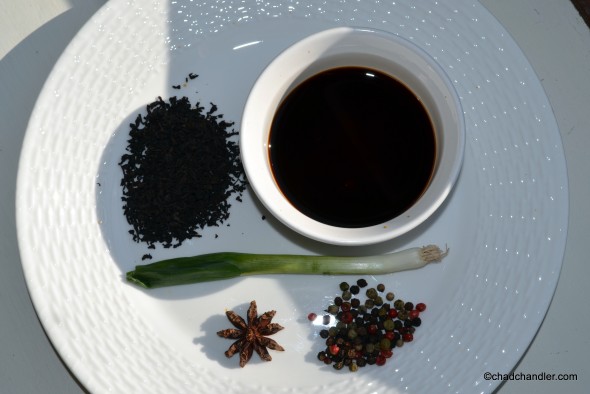
Refill the pot with fresh water. Add all of the ingredients and warm everything over medium-low heat until the water hits 160°. This is your steeping temperature. You don’t need to reach a simmer. Let the eggs steep for about an hour with the lid off. The sauce will leak through the cracks in the egg shells and give the whites that marbled look.
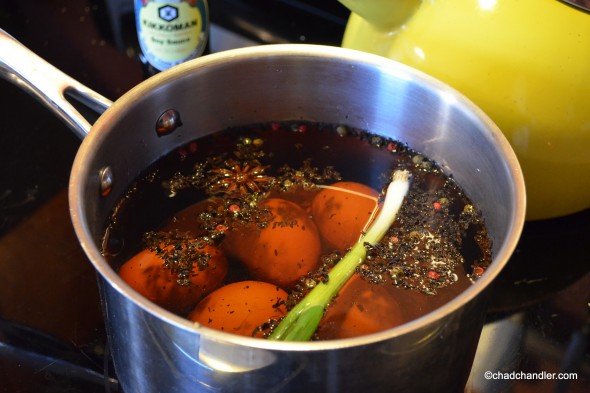
Anyone who’s ever over-boiled eggs has had to deal with green yolks. The yolks darken because of the high temperature of the water, not necessarily because of the cooking time unless you’ve left them in the pot for way too long. This recipe varies time, so you need to try to keep a controlled temperature. As long as you don’t let the pot get too hot, the yolks should stay soft and yellow in the center.
After the eggs have steeped for about an hour, remove the pot from the heat and allow the water and the eggs to come to room temperature.
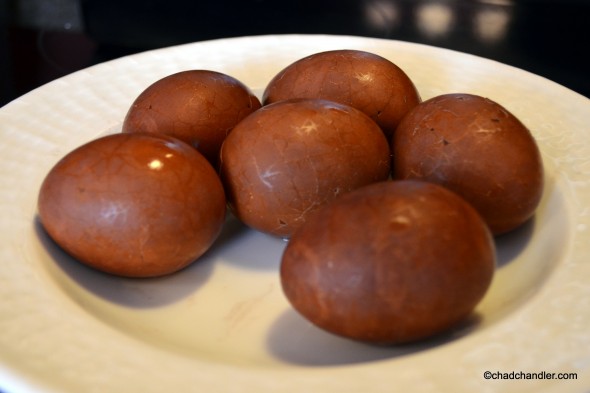
Serve either whole or halved. At the Lu San Chinese Garden Tea House, they served my egg sliced in a bowl with the shell so that I could see the marbling. They also garnished their egg with soy sauce, sesame seeds, pickled peppers, seaweed, and sliced green onion. Here’s a picture.
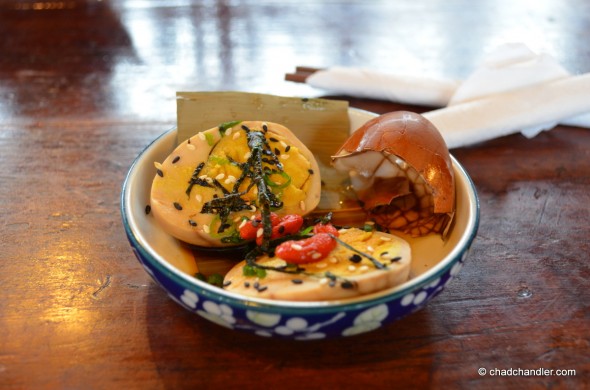
I just garnished with soy sauce, sesame seeds, and sliced green onion. My eggs turned out just as good as the ones from the Tea House.
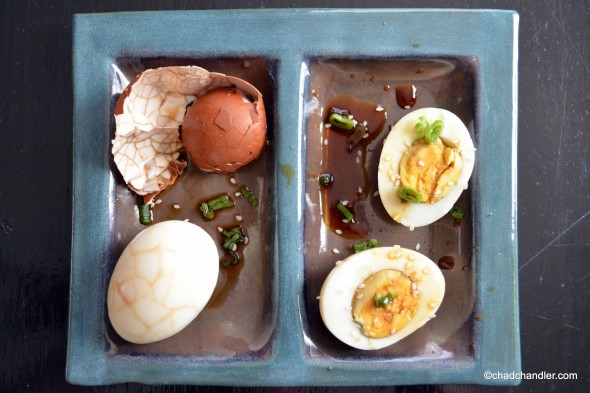
These are so much better than plain hard-boiled eggs. It seems like a big production, but it’s really not. There’s about 10 minutes of actual activity. The rest of the time, you can do something else while the pot steeps.
This is tasty way to rejuvenate your appetite for hard-boiled eggs. And at a time when high-protein diets are all the rage, this is a great way to pre-cook a bunch of snacks for the work week. Honestly, I never imagined hard-boiled eggs would go so well with toasted sesame seeds, soy sauce, and a little sriracha.






